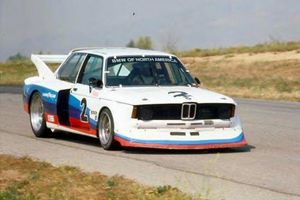.
BMW 320 Turbo
| place image here in 300 pixels | |
| BMW 320 Turbo | |
|---|---|
| Race Car | |
| Category | |
| Constructor | |
| Chassis | |
| Suspension (front) | |
| Suspension (rear) | |
| Engine | |
| Power | N/A hp @ N/A rpm N/A lb-ft. of torque @ N/A rpm |
| Transmission | |
| Fuel | |
| Tyres | |
| Notable entrants | |
| Notable drivers | |
| Debut | pending (if not yet introduced) |
| Races competed | |
| Race victories | |
| Constructors' Championships | |
| Drivers' Championships | |
| Pole positions | |
| Fastest laps | |
| Designer | Designer (lead designer if it was a team effort) |
The BMW 320 became BMW's next weapon in the European racing scene after the exit of the highly successful 3.0 CSL. Both non-turbo and turbocharged versions of the highly successful Formula 2 'M12' engine powered these racecars. The BMW Junior Team who's up and coming drivers Eddie Cheever, Marc Surer and Manfred Winkelhock drove to eight victories made the non-turbo versions famous in the 1977 German Racing Championship.
The Turbo versions of these cars were raced in both Europe and the US. The European turbo cars had 1.5 liter engines while the US versions had 2.0 liter engines. The BMW owned versions of the 320 turbo you see here was campaigned by Team McLaren and driven by David Hobbs to 7 wins in the IMSA Camel GT series in 1977 and 1978. American Jim Busby also campaigned a sister car in the 1979 IMSA Camel GT series.
Significantly, the 320 turbo engine was the test bed for the BMW/Brabham BT52 that took Nelson Piquet to the 1983 Formula 1 World Championship.
Gallery
Complete Racing Results
(key) (results in bold indicate pole position)
| Year | Team | Engine | Tyres | Drivers | 1 | 2 | 3 | 4 | 5 | 6 | 7 | 8 | 9 | 10 | 11 | 12 | 13 | 14 | 15 | 16 | 17 | Points | WCC |
|---|---|---|---|---|---|---|---|---|---|---|---|---|---|---|---|---|---|---|---|---|---|---|---|
| YYYY | (Constructor) | (Engine) | (Tyre code) | ||||||||||||||||||||
Notes and references
See Also
External links

| |
| BMW 320 Turbo | |
|---|---|
| BMW | |
| aka | |
| Production 1977 | |
| Class Race Car | |
| Body Style 2 door Coupe | |
| Length | |
| Width | |
| Height | |
| Wheelbase | |
| Weight | |
| Transmission | |
| Engine 2 Litre I-4 | |
| Power 300-bhp & | |
| Similar | |
| Designer | |

